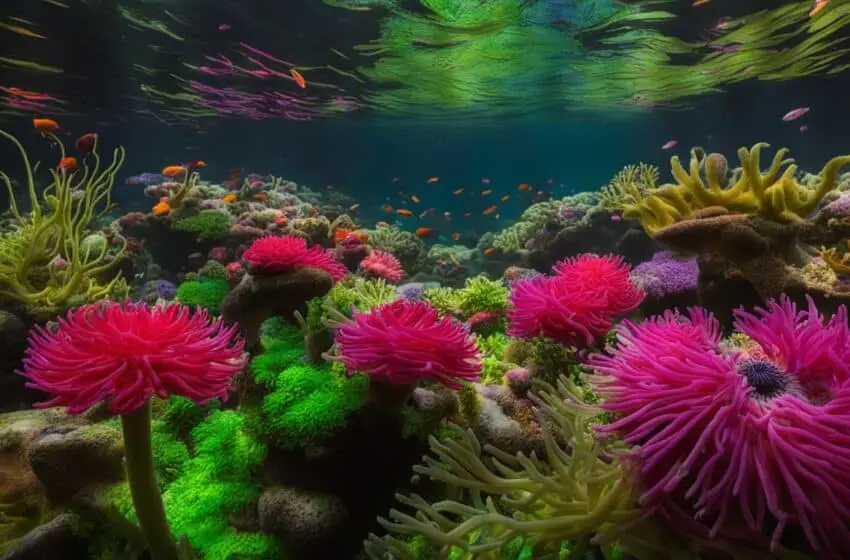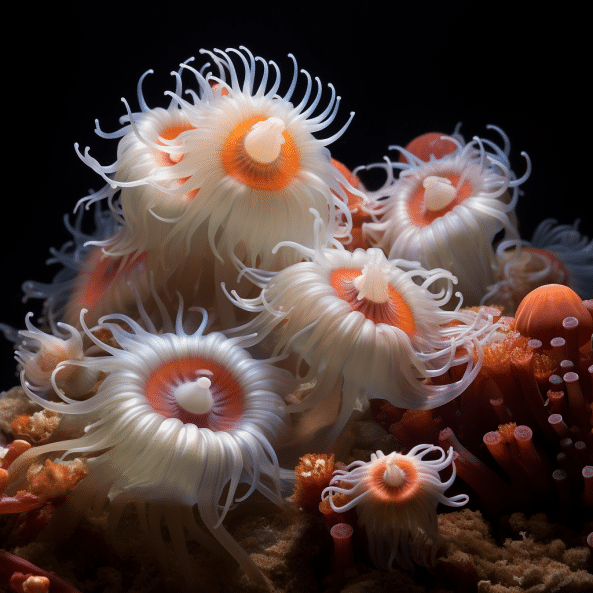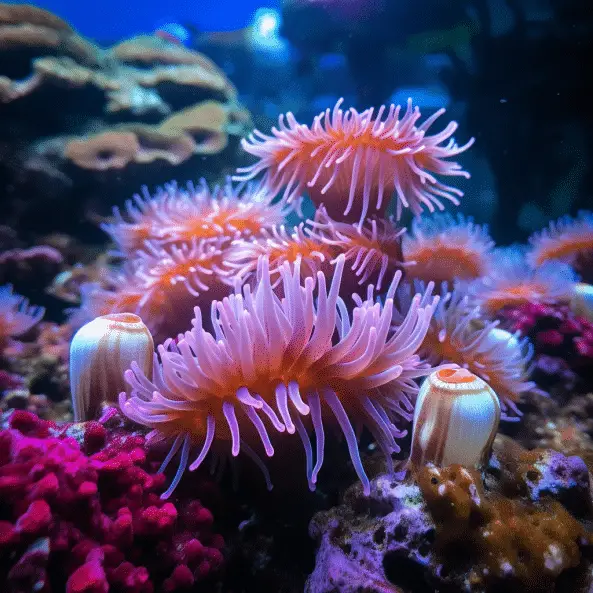Sustaining Anemones: Challenges and Triumphs in Captive Breed

Captive breeding of anemones is a practice that aims to preserve and protect these marine jewels. While in theory it may seem like a straightforward process, there are various techniques and challenges involved. According to Daphne Fautin, an invert zoologist and professor, most species of anemones release gametes into the water for reproduction. However, fewer than a dozen species have been studied in terms of their reproductive biology. The natural spawning and larval life of anemones are still not fully understood. In home aquariums, it can be difficult to simulate the natural environment required for successful breeding. Despite these obstacles, sustainable anemone breeding methods are being developed to assure their survival.
Key Takeaways:
- Captive breeding of anemones is a practice aimed at preserving and protecting these marine organisms.
- Understanding the reproductive biology of anemones is crucial for successful breeding efforts.
- Simulating the natural environment in home aquariums can be challenging but is necessary for breeding success.
- Ongoing efforts are being made to develop sustainable anemone breeding methods.
- Successful captive breeding programs are crucial for the long-term survival of anemone species.
Captive breeding programs have emerged as crucial initiatives in the conservation of anemone species. By breeding anemones in controlled environments, researchers and organizations are making significant contributions to the preservation of these marine organisms.
These strategies enhance population numbers and reduce wild-catch dependence, assuring anemone species’ sustainability.
Anemone breeding programs worldwide have shown
the success and importance of captive breeding programs. One such example is the breeding of Anemonia sulcata by iMare Natural in Spain. Through careful breeding and control of environmental factors, they have managed to not only increase the population of this particular species but also contribute to its conservation by reducing the exploitation of wild populations.
“Captive breeding programs for anemones are vital for their long-term survival. By reducing the demand for wild-caught specimens and increasing their population through controlled breeding, we can ensure the preservation of these beautiful creatures.”
– Dr. Stephanie Carter, Marine Biologist
Furthermore, captive breeding programs also bring economic benefits. Anemones are highly valued in the culinary industry, with their unique flavors and vibrant colors. By reducing the pressure on wild populations through captive breeding, these programs help sustain the availability of anemones for consumption, benefiting not only the environment but also the commercial sector.
The Benefits of Anemone Captive Breeding Programs

The benefits of anemone captive breeding programs are multifaceted. These programs contribute to the conservation of anemone species, reduce the impact on wild populations, and support the economic sustainability of the culinary industry. By investing in and supporting these initiatives, we can ensure the long-term survival of anemones, preserving their beauty and ecological significance for generations to come.
Techniques for Captive Breeding of Anemones
The captive breeding of anemones requires a range of techniques to ensure successful reproduction and growth in controlled environments. One key aspect is providing the appropriate hydraulic, physical-chemical, and environmental lighting conditions that mimic the anemones’ natural habitat. Whether in open systems or closed systems like recirculating aquaculture systems (RAS), anemones adapt well to captive conditions. This allows researchers to carefully monitor and optimize factors such as water quality, temperature, and light intensity to create ideal breeding conditions.
Anemone species that reproduce sexually face a challenge. They need to develop new anemones year-round. Understanding the reproductive biology of anemones is essential to determine the appropriate strategies for inducing and facilitating successful mating. This includes identifying the timing, temperature, and other environmental cues that trigger spawning. By manipulating these factors in captivity, researchers can increase the likelihood of successful fertilization and larval development.
Another important consideration in captive breeding programs is the availability of suitable food sources for the anemones. These organisms have specific dietary requirements, often feeding on small marine organisms. To ensure long-term sustainability, researchers are exploring alternative feed formulations that utilize sustainably cultured marine organisms and vegetable proteins. Developing nutritionally balanced diets that meet the nutritional needs of captive anemones is crucial for their growth and overall well-being.
The Importance of Sustainable Anemone Breeding Methods
Sustainable anemone breeding practices are essential for captive breeding success. Researchers can lessen their ecological impact by employing renewable energy to maintain breeding facility conditions.
To stop infections in captive animals, we need to use biosecurity and prevent diseases. These procedures protect bred anemone health and genetic variety.
As researchers learn more about anemones’ reproductive biology and environmental needs, captive breeding methods evolve. Scientists, conservationists, and the aquaculture industry are creating sustainable breeding methods to safeguard anemone species and assist conservation efforts.
| Techniques for Captive Breeding of Anemones |
|---|
| Provide appropriate hydraulic, physical-chemical, and environmental lighting conditions |
| Manipulate factors such as timing, temperature, and environmental cues to induce successful mating |
| Develop alternative feed formulations using sustainably cultured marine organisms and vegetable proteins |
| Implement sustainable practices, such as using renewable energy sources and strict biosecurity measures |
Conclusion
Captive breeding programs for anemones are of utmost importance in our ongoing efforts to conserve and protect these mesmerizing marine organisms. Despite the challenges faced, dedicated researchers and organizations are actively working towards sustainable solutions.
Understanding the reproductive biology of anemones and providing suitable breeding conditions remain key focus areas. However, the success achieved through various breeding projects and the economic benefits derived from captive breeding programs emphasize the significance of these initiatives in preserving anemone species.
Continuous research and the implementation of best practices are imperative in ensuring the long-term conservation of anemones in the US and worldwide. Through the concerted efforts of the scientific community and other stakeholders, captive breeding offers hope in our mission to safeguard these captivating creatures for generations to come.

FAQ
What is the purpose of captive breeding programs for anemones?
Captive breeding programs aim to preserve and protect anemone species by increasing their population numbers and reducing reliance on wild-caught individuals.
Have there been successful anemone breeding projects?
Yes, successful anemone breeding projects have been carried out, such as the breeding of Anemonia sulcata by iMare Natural in Spain.
What are the benefits of captive breeding programs for anemones?
Besides contributing to the preservation of anemone species, captive breeding programs also have economic benefits by reducing the pressure on wild populations and sustaining their availability for consumption in the culinary industry.
What techniques are used for captive breeding of anemones?
Techniques for captive breeding of anemones include providing appropriate hydraulic, physical-chemical, and environmental lighting conditions to mimic their natural habitat, as well as finding sustainable feed supplies to meet their specific dietary requirements.
How important are captive breeding programs for anemone conservation?
Captive breeding programs play a crucial role in the conservation efforts of anemones, offering hope for their long-term conservation both in the US and worldwide.



